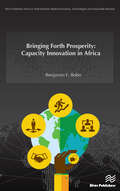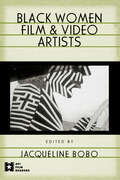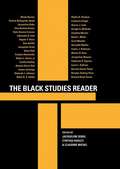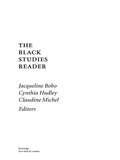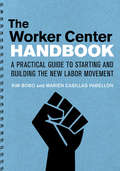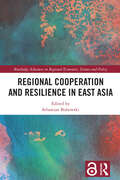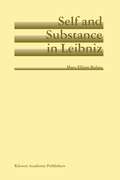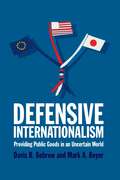- Table View
- List View
Cytokines and Growth Factors in Blood Transfusion: Proceedings of the Twentyfirst International Symposium on Blood Transfusion, Groningen 1996, organized by the Red Cross Blood Bank Noord Nederland (Developments in Hematology and Immunology #32)
by BobLöwenberg P. C. Das Cees Th. SmitSibingaCytokines are cellular growth factors which also provide communication between cells and their milieu. This clearly is an exciting area in modern medicine that will have significant impact on various facets of transfusion. Erythropoietin therapy stimulates red cell production while thrombopoietin seems to positively affect megakaryopoiesis and can be an added armamentarium for the thrombocytopenic patient. Using haematnopoietic growth factors, stem cells could be mobilized early to the peripheral blood for collection and subsequent transplantation into haemato-oncology patients instead of bone marrow transplantation. Using a cocktail of cytokines in cell culture, stem cells could be expanded and selected for therapy. Cytokines and growth factors can even be modified, which may lead to successful gene therapy in malignancies, including solid tumour vaccines. However, the presence of cytokines in certain blood products could have biological effects following transfusion, although its clinical relevance needs to be ascertained. There is much potential for the use of cytokines in the treatment of infections. Early diagnostic methods are now available to monitor their levels and relevance. It is likely that cytokines will increasingly play a role in therapy and could develop our fundamental knowledge about the development of T-cells. An ethical dilemma remains, however, regarding the use of cytokines in healthy donors for harvesting suitable specific cells. Longer clinical observation will be necessary to gather the necessary information. Cytokines and growth factors in blood transfusion was the theme of the 21st International Symposium in Blood Transfusion, where twenty clinicians and scientists, experts in their own fields, were invited to update the above information. Their findings are presented in four sections in this volume: Fundamental aspects - cytokines in development of T-cells, growth factors in haematopoiesis, growth factor receptors and signal transduction, cytokine response in platelet and whole blood transfusions. Function, production and diagnosis &endash; laboratory diagnostics of cytokines and growth factors, cytokines in blood components, cytokines and growth factors in cell expansions, cytokines for genetic modification towards gene therapy, progenitor cells from healthy donors. Application in clinical medicine &endash; clinical relevance of cytokines in transfusion products, cytokines and growth factors in solid tumours, gene therapy in malignancies, vaccine strategies inducing T-cell immunity against tumours, cytokines in the treatment of infections, thrombopoietin and megakaryopoiesis. Future potential use in transfusion medicine &endash; erythropoietin, immunotherapy, ethical aspects of the use of cytokines and growth factors in donors, potential of cytokines and growth factors in transfusion medicine.
Bringing Forth Prosperity: Capacity Innovation in Africa
by Benjamin BoboPath to Capacity Innovation: An Africa-MNC Strategic Alliance, a policy framework is advanced proposing a strategic alliance between African countries -represented by NEPAD- and the multinational corporation with input from the NGO and couched upon an NEPAD-MNC-NGO cross-fertilizing integrative structure. Capacity innovation is the key to Africa's transformation: with the appropriate catalysts, innovation and transformation are but a matter of time in gestation. The first of two major catalysts necessary to prompting this change so long sought by Africans came at the adoption of the New Partnership for Africa's Development. It is one of the most profound collaborations of African Heads of State. The second catalyst is proposed in this work in the form of the multinational corporation as change agent for the innovation process working in alliance with NEPAD as Africa's spokesperson for innovation. The policy framework for African capacity innovation is the material product along with discourse for redress of corruption and security policy narrative for protecting the assets of multinational corporations.Bringing Forth Prosperity: Capacity Innovation in Africa questions capital theory as a development construct and an appropriate platform upon which sustained capacity innovation in Africa may emerge; explores Africa's road to modernity in the context of selected development constructs and assesses capacity innovation from a top down-bottom up perspective purposely to serve as backdrop to the Africa-MNC strategic alliance framework; constructs country capacity ID to identify internal resources available to African countries to support capacity innovation; conceptualizes the Africa-MNC strategic alliance to convey a capacity innovation philosophy; articulates an African capacity innovation policy framework to guide the Alliance through a series of actions designed to prompt innovation activity and set the continent on a course to sustained transformation; and articulates a scheme to protect assets -human and physical- derived through the Africa-MNC strategic alliance.
Bringing Forth Prosperity: Capacity Innovation in Africa
by Benjamin BoboPath to Capacity Innovation: An Africa-MNC Strategic Alliance, a policy framework is advanced proposing a strategic alliance between African countries -represented by NEPAD- and the multinational corporation with input from the NGO and couched upon an NEPAD-MNC-NGO cross-fertilizing integrative structure. Capacity innovation is the key to Africa's transformation: with the appropriate catalysts, innovation and transformation are but a matter of time in gestation. The first of two major catalysts necessary to prompting this change so long sought by Africans came at the adoption of the New Partnership for Africa's Development. It is one of the most profound collaborations of African Heads of State. The second catalyst is proposed in this work in the form of the multinational corporation as change agent for the innovation process working in alliance with NEPAD as Africa's spokesperson for innovation. The policy framework for African capacity innovation is the material product along with discourse for redress of corruption and security policy narrative for protecting the assets of multinational corporations.Bringing Forth Prosperity: Capacity Innovation in Africa questions capital theory as a development construct and an appropriate platform upon which sustained capacity innovation in Africa may emerge; explores Africa's road to modernity in the context of selected development constructs and assesses capacity innovation from a top down-bottom up perspective purposely to serve as backdrop to the Africa-MNC strategic alliance framework; constructs country capacity ID to identify internal resources available to African countries to support capacity innovation; conceptualizes the Africa-MNC strategic alliance to convey a capacity innovation philosophy; articulates an African capacity innovation policy framework to guide the Alliance through a series of actions designed to prompt innovation activity and set the continent on a course to sustained transformation; and articulates a scheme to protect assets -human and physical- derived through the Africa-MNC strategic alliance.
Modern Coin Magic: 116 Coin Sleights And 236 Coin Tricks (Dover Magic Books)
by J. B. BoboWhen party guests request a few tricks, be prepared. Ask for a coin, and perform some of the tricks in this book. Because you will not have been aided by special stage apparatus, the results will be all the more astonishing. As tricks with coins are so readily improvised, they are among the most impressive forms of legerdemain.This book is the most complete treatise ever written on sleight-of-hand coin conjuring. Celebrated magician J. B. Bobo has gathered here the best and most useful of all coin tricks — not only his own, but those of some four dozen notable prestidigitators, including such greats as Robert-Houdin, Professer Hoffman, and — the greatest of all coin conjurers — T. Nelson Downs.All the tested, traditional methods of coin magic are here. Bobo has added to these the best of the modern innovations, while eliminating all of the out-of-date and impractical sleights of his sources. You will learn all about palms, holds, flips, switches, change-over, steals, cuffing, sleeving, and other sleight-of-hand techniques; coin tricks requiring special devices are also included. The author guides how systematically from basic techniques, concealments, and vanishes, through integrated tricks, to complete routine acts (18 in all). His clear explanations are splendidly complemented by 510 of Nelson C. Hahne's crisp illustrations.Sleight-of-hand magic has consistently earned the respect of professional magicians. If you are yet an amateur, this easy-to-follow manual — together with regular practice — is the surest route to professional-level competence. For professionals, this volume is a convenient encyclopedic reference that gathers in one place all the best coin magic from antiquity to modern times.
Black Women Film and Video Artists (AFI Film Readers)
by Jacqueline BoboFirst published in 1998. Routledge is an imprint of Taylor & Francis, an informa company.
Black Women Film and Video Artists (AFI Film Readers)
by Jacqueline BoboFirst published in 1998. Routledge is an imprint of Taylor & Francis, an informa company.
The Black Studies Reader
by Jacqueline Bobo Cynthia Hudley Claudine MichelFirst published in 2004. Routledge is an imprint of Taylor & Francis, an informa company. 9780203491348 9780415945547
The Black Studies Reader
by Jacqueline Bobo Cynthia Hudley Claudine MichelFirst published in 2004. Routledge is an imprint of Taylor & Francis, an informa company.
The Black Studies Reader
by Jacqueline Bobo Cynthia Hudley Claudine MichelFirst published in 2004. Routledge is an imprint of Taylor & Francis, an informa company.
The Black Studies Reader (PDF)
by Jacqueline Bobo Cynthia Hudley Claudine MichelBlack Studies emerged from the tumultuous social and civil rights movements of the 1960s and empowered African Americans to look at themselves in new ways and pass on a dignified version of Black history. However, it also enriched traditional disciplines in profound and significant ways. With an all-star cast of contributors, the Black Studies Reader takes on the history and future of this multi-faceted academic field. Topics include Black Feminism, Cultural Politics, Black Activism, Lesbian and Gay Issues, African American literature and film, education, and religion. This authoritative collection takes a critical look at the current state of Black Studies and speculates on where it may go from here. 9780203491348 9780415945547
The Worker Center Handbook: A Practical Guide to Starting and Building the New Labor Movement
by Kim Bobo Marien Casillas PabellonWorker centers are becoming an important element in labor and community organizing and the struggle for fair pay and decent working conditions for low-wage workers, especially immigrants. There are currently more than two hundred worker centers in the country, and more start every month. Most of these centers struggle as they try to raise funds, maintain stable staff, and build a membership base. For this book, Kim Bobo and Marién Casillas-Pabellón, two women with extensive experience supporting and leading worker centers, have interviewed staff at a broad range of worker centers with the goal of helping others understand how to start and build their organizations. This book is not theoretical, but rather is designed to be a practical workbook for staff, boards, and supporters of worker centers. Geared toward groups that want to build worker centers, this book discusses how to survey the community, take on an initial campaign, recruit leaders, and raise seed funds. Bobo and Casillas-Pabellón also provide a wealth of advice to help existing centers become stronger and more effective. The Worker Center Handbook compiles best practices from around the country on partnering with labor, enlisting the assistance of faith communities and lawyers, raising funds, developing a serious membership program, integrating civic engagement work, and running major campaigns. The authors urge center leaders to both organize and build strong administrative systems. Full of concrete examples from worker centers around the country, the handbook is practical and honest about challenges and opportunities.
Order and Convexity in Potential Theory: H-Cones (Lecture Notes in Mathematics #853)
by N. Boboc G. Bucur A. CorneaPeptide and Protein Interaction with Membrane Systems: Applications to Antimicrobial Therapy and Protein Drug Delivery (Springer Theses)
by Sara BoboneIn her thesis, Sara Bobone outlines spectroscopic studies of antimicrobial peptides (AMPs) which are promising lead compounds for drugs used to fight multidrug resistant bacteria. Bobone shows that AMPs interact with liposomes and she clarifies the structure of pores formed by one of these molecules. These results help us to understand how AMPs are selective for bacterial membranes and how their activity can be finely tuned by modifying their sequence. Findings which solve several conundrums debated in the literature for years. In addition, Bobone uses liposomes as nanotemplates for the photopolymerization of hydrogels - exploiting the self- assembly properties of phospholipids. Bobone was able to trap an enzyme using nanometeric particles, while still allowing its activity by the diffusion of substrates and products through the network of the polymer. The innovative nano devices described in this thesis could solve many of the hurdles still hampering the therapeutic application of protein-based drugs.
Regional Cooperation and Resilience in East Asia (Routledge Advances in Regional Economics, Science and Policy)
by Sebastian BobowskiThis book argues that a resilient region should act reactively and proactively in the face of shocks and disruptions and asserts that the institutionalization of regional cooperation may be the answer to development challenges in times of uncertainty and instability.It considers regional, transregional, and subregional cooperation initiatives for building regional resilience and critically examines a broad spectrum of issues, such as international security and trade, economic development, value chains in production, and social welfare. Adopting the concept of resilience allows for a holistic, dynamic, and systematic approach to the studies on the regional process of institutionalization, responsiveness, and adaptability to challenging circumstances. The economic and social indicators of the countries in the region are examined alongside an analysis of the regional institutional architecture.The reader is acquainted with the essence of resilience concerning each category of challenges and the mechanisms of its achievement and strengthening through regional integration. The interdisciplinary character of the book makes it suitable for usage not only by economists but also by lawyers. As such, the book will be helpful to scholars and students of international economics, international security, and policymakers.
Self and Substance in Leibniz
by Marc Elliott BobroThere is a close connection in Gottfried Wilhelm Leibniz’s mind between the notions of self and substance. R. W. Meyer, in his classic 1948 text, Leibnitz and the Seventeenth-Century Revolution, writes that “the monad … is nothing but a 1 représentation (in both senses of the French word) of Leibniz’s personality in metaphysical symbols; and there was, under contemporary circumstances, no need 2 to ‘introduce’ this concept apart from ‘propounding’ it. ” It is not clear what Meyer means here except that from the consideration of his own self, in some way Leibniz comes to his concept of simple substance, or monad. Herbert Carr, in an even earlier work, notes that Leibniz held that “the only real unities in nature are formal, not material. … [and] [f]or a long time Leibniz was content to call the formal unities or substantial forms he was speaking about, souls. This had the advantage that it referred at once to the fact of experience which supplies the very 3 type of a substantial form, the self or ego. ” Finally, Nicholas Rescher, in his usual forthright manner, states that “[i]n all of Leibniz’s expositions of his philosophy, 4 the human person is the paradigm of a substance.
Knowledge in a Nutshell: The complete guide to the great psychoanalyst, including the unconscious, archetypes and the self (Knowledge in a Nutshell #4)
by Gary Bobroff"An excellent primer on Jungian concepts. Highly recommended" - Jung Utah review by A. Butler "One of the best introductions to Jung's psychology! - André De Koning, past President Australian and New Zealand Society for Jungian AnalystsCarl Jung was the founder of analytical psychology who revolutionized the way we approached the human psyche. Drawing on Eastern mysticism, mythology and dream analysis to develop his theories, Jung proposed many ideas which are still influential today, including introversion, extroversion and the collective unconscious. Knowledge in a Nutshell: Carl Jung introduces psychologist Jung's ideas in an engaging and easy-to-understand format. Jungian psychology expert Gary Bobroff breaks down the concepts of the psyche, collective unconscious, archetypes, personality types and more in this concise book. He also explores the influence on Eastern philosophy and religion on Jung's ideas, and how spiritualism enriched his theories. With useful diagrams and bullet-point summaries at the end of each chapter, this book provides an essential introduction to this influential figure and explains the relevance of Jung's ideas to the modern world.ABOUT THE SERIES: The 'Knowledge in a Nutshell' series by Arcturus Publishing provides engaging introductions to many fields of knowledge, including philosophy, psychology and physics, and the ways in which human kind has sought to make sense of our world.
Roads to Glory: Late Imperial Russia and the Turkish Straits (International Library of Twentieth Century History)
by Ronald P. BobroffUntil now, it has been accepted that the Turkish Straits - the Russian fleet's gateway to the Mediterranean - were a key factor in shaping Russian policy in the years leading to World War I. Control of the Straits had always been seen as the major priority of Imperial Russia's foreign policy. In this powerfully argued revisionist history, Ronald Bobroff exposes the true Russian concern before the outbreak of war: the containment of German aggression. Based on extensive new research, Bobroff argues that under the pressures of World War I, Russian foreign policy became less flexible than in the years before, dragging out the war and opening the door to revolution. The Straits were a crucial strategic and economic zone for Russia but became a secondary concern as the pre-war German threat grew. Russian leaders maintained the traditional preference for control of the Straits by a weak Ottoman Empire. At the start of the war, Russian leaders maintained this policy toward the Straits. However, once Turkey joined the war on the side of the Central Powers, Russia began to lay claim to the Straits region. As confidence in the tsar dropped and sacrifices mounted during the lengthening war, the allegiance of many policy makers shifted from monarch to state and even people. To satisfy the people, the Russian foreign minister made acquisition of the Turkish Straits a primary goal, at the expense of strategic necessity. The foreign minister ignored the army's desires for a separate peace with Turkey that might free up troops for the fight against Germany and Austia-Hungary at the possible cost of acquiring the Straits. The prolonged war set the stage for the popular outbursts of 1917. Roads to Glory provides fascinating new insights into Russia's state development before the revolution through a thorough examination of the policies and personal correspondence of its policy makers. Through his detailed examination of the rivalries and alliances of the Triple Entente, Bobroff sheds new light on European diplomacy at the beginning of the twentieth century.
Qualitative Reasoning about Physical Systems
by Daniel G. BobrowThis volume brings together current work on qualitative reasoning. Its publication reflects the maturity of qualitative reasoning as a research area and the growing interest in problems of reasoning about physical systems.The papers present knowledge bases for a number of very different domains, including heat flow, transistors, and digital computation. A common theme of all these papers is explaining how physical systems work. An important shared criterion is that the behavioral description must be compositional, that is the description of a system's behavior must be derivable from the structure of the system.This material should be of interest to anyone concerned with automated reasoning about the real (physical) world.
Defensive Internationalism: Providing Public Goods in an Uncertain World
by Davis B. Bobrow Mark A. Boyer"The authors' carefully crafted analysis will influence thought and the policy debate on the tradeoff between unilateralism and multilateralism for decades to come." -Todd Sandler, Robert R. and Katheryn A. Dockson Professor of International Relations & Economics, University of Southern California "Boyer and Bobrow's well-written, data-rich analysis of such pressing issues as development assistance, debt management, UN peacekeeping, and environmental protection makes Defensive Internationalism a highly original and provocative contribution to the study of global governance." -Yale H. Ferguson, Co-Director, Center for Global Change and Governance, Rutgers University In this pathbreaking study, authors Davis B. Bobrow and Mark A. Boyer argue for "muted optimism" about the future of international cooperation. Leaders of a growing movement that integrates constructivism into traditional international studies concepts and methods, Bobrow and Boyer analyze four key international issues: development cooperation, debt management, peacekeeping operations, and environmental affairs. Their approach integrates elements of public goods theory, identity theory, new institutionalism, and rational choice. Defensive Internationalism is a well-written, creative and coherent synthesis of ideas that have up to now been considered irreconcilable. It is appropriate for upper-level undergraduate and graduate students in international relations, conflict studies, and political economy, and promises to become a foundational work in its field. Davis B. Bobrow is Professor of Public and International Affairs and Political Science at the University of Pittsburgh. Mark A. Boyer is Professor of Political Science at the University of Connecticut.
Chinese Animated Film and Ideology: Tradition, Innovation, and Interculturality (Focus Animation Ser.)
by Olga BobrowskaThis book presents a contextualized overview of the history of Chinese animated film, pointing out the most influential self-definitions of Chinese culture employed in animation art of Mao Zedong’s rule (1949–1976) but largely focusing on the representation strategies created in the times of reforms and opening-up under Deng Xiaoping (1978–1989/1992).Deeply grounded in cultural studies, the book employs an interdisciplinary approach, interlacing the reflection with the perspectives of political science, film studies, and film festival studies. It focuses on phenomena anchored to the paradigms of nationalization, reform, and internationalization: among them, nuanced understanding of the minzu (national) category (including the classic style of Chinese animation); invention of wash-and-ink painting animation (shuimo donghua); renewal of film theory and animated film language; soft power and cultural diplomacy; and regular access and co-creation of the international industry (festival distribution).This book will be of great interest to those in the fields of animation studies, film studies, political science, Chinese area studies, and Chinese philology.
Chinese Animated Film and Ideology: Tradition, Innovation, and Interculturality (Focus Animation Ser.)
by Olga BobrowskaThis book presents a contextualized overview of the history of Chinese animated film, pointing out the most influential self-definitions of Chinese culture employed in animation art of Mao Zedong’s rule (1949–1976) but largely focusing on the representation strategies created in the times of reforms and opening-up under Deng Xiaoping (1978–1989/1992).Deeply grounded in cultural studies, the book employs an interdisciplinary approach, interlacing the reflection with the perspectives of political science, film studies, and film festival studies. It focuses on phenomena anchored to the paradigms of nationalization, reform, and internationalization: among them, nuanced understanding of the minzu (national) category (including the classic style of Chinese animation); invention of wash-and-ink painting animation (shuimo donghua); renewal of film theory and animated film language; soft power and cultural diplomacy; and regular access and co-creation of the international industry (festival distribution).This book will be of great interest to those in the fields of animation studies, film studies, political science, Chinese area studies, and Chinese philology.
Chinese Animated Film and Ideology, 1940s-1970s: Fighting Puppets (Focus Animation Ser.)
by Olga BobrowskaThis book examines animated propaganda produced in mainland China from the 1940s to the 1970s. The analyses of four puppet films demonstrate how animation and Maoist doctrine became tightly but dynamically entangled. The book firstly contextualizes the production conditions and ideological contents of The Emperor’s Dream (1947), the first puppet film made at the Northeast Film Studio in Changchun. It then examines the artistic, intellectual, and ideological backbone of the puppet film Wanderings of Sanmao (1958). The book presents the means and methods applied in puppet animation filmmaking that complied with the ideological principles established by the radical supporters of Mao Zedong in the first half of the 1960s, discussing Rooster Crows at Midnight (1964). The final chapter discusses The Little 8th Route Army (1973), created by You Lei in the midst of the Cultural Revolution. This book will be of great interest to those in the fields of animation studies, film studies, political science, Chinese area studies, and Chinese philology.
Chinese Animated Film and Ideology, 1940s-1970s: Fighting Puppets (Focus Animation Ser.)
by Olga BobrowskaThis book examines animated propaganda produced in mainland China from the 1940s to the 1970s. The analyses of four puppet films demonstrate how animation and Maoist doctrine became tightly but dynamically entangled. The book firstly contextualizes the production conditions and ideological contents of The Emperor’s Dream (1947), the first puppet film made at the Northeast Film Studio in Changchun. It then examines the artistic, intellectual, and ideological backbone of the puppet film Wanderings of Sanmao (1958). The book presents the means and methods applied in puppet animation filmmaking that complied with the ideological principles established by the radical supporters of Mao Zedong in the first half of the 1960s, discussing Rooster Crows at Midnight (1964). The final chapter discusses The Little 8th Route Army (1973), created by You Lei in the midst of the Cultural Revolution. This book will be of great interest to those in the fields of animation studies, film studies, political science, Chinese area studies, and Chinese philology.
An Operator Semigroup in Mathematical Genetics: Lyapunov Equation Model Of Drift And Mutation: Population Dependence And Asymptotic Behavior (SpringerBriefs in Applied Sciences and Technology)
by Adam Bobrowski Marek KimmelThis authored monograph presents a mathematical description of the time evolution of neutral genomic regions in terms of the differential Lyapunov equation. The qualitative behavior of its solutions, with respect to different mutation models and demographic patterns, can be characterized using operator semi group theory.Mutation and drift are two of the main genetic forces, which act on genes of individuals in populations. Their effects are influenced by population dynamics. This book covers the application to two mutation models: single step mutation for microsatellite loci and single-base substitutions. The effects of demographic change to the asymptotic of the distribution are also covered. The target audience primarily covers researchers and experts in the field but the book may also be beneficial for graduate students.
Aggregate Resources: A Global Perspective
by P. T. BobrowskyAggregate Resources provides a comprehensive collection of 27 diverse scientific papers on aggregate topics, such as geology of deposits, geophysical exploration techniques, deposit prediction and modeling, land-use case studies, production values and trends, geotechnical properties, legislation politics and others. This diversity in subject matter is further enhanced by relying on contributions from a number of countries including Australia, Belgium, Canada, Lebanon, the Netherlands, Norway, South Africa, the United Kingdom and the United States. The range of topical papers and representative countries, coupled with the global significance of the resources prompted the title Aggregate Resources: A global perspective. The book will appeal to all those involved with aggregate resources: geologists, producers, technicians , construction engineers, developers, land-use planners, legislators, academics and the public consumer, especially since all of us are in some manner, directly dependent or indirectly affected by this resource. *Each chapter is a study on a particular area of importance for aggregate producers. Pit & Quarry, April 1998.

